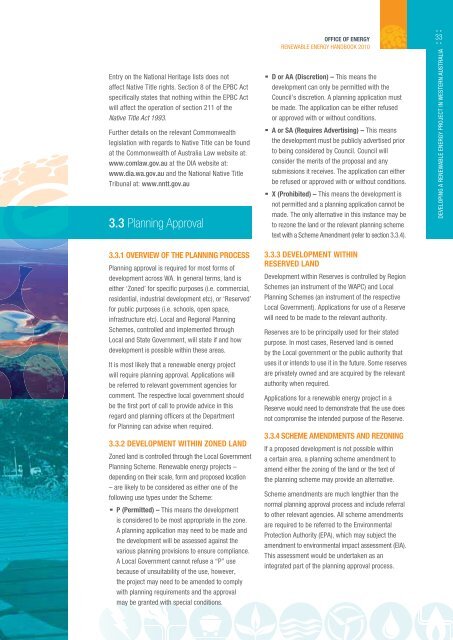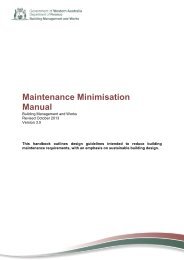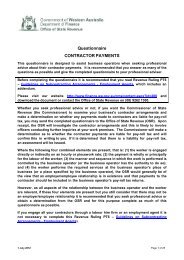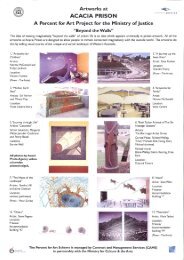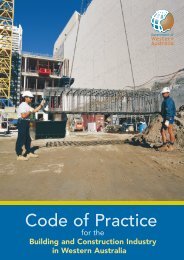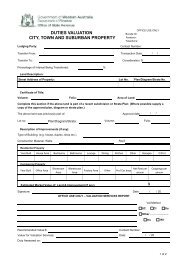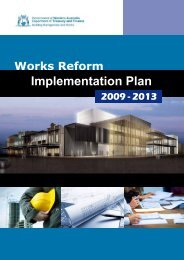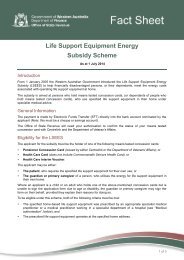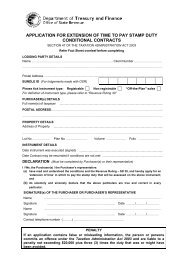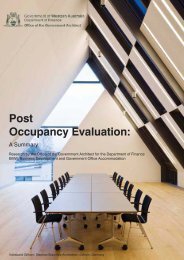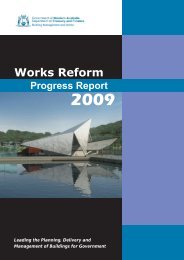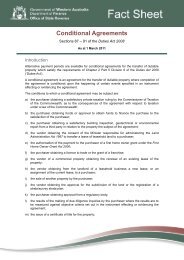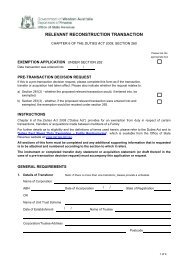Renewable Energy Handbook 2010 - Department of Finance - The ...
Renewable Energy Handbook 2010 - Department of Finance - The ...
Renewable Energy Handbook 2010 - Department of Finance - The ...
Create successful ePaper yourself
Turn your PDF publications into a flip-book with our unique Google optimized e-Paper software.
Entry on the National Heritage lists does notaffect Native Title rights. Section 8 <strong>of</strong> the EPBC Actspecifi cally states that nothing within the EPBC Actwill affect the operation <strong>of</strong> section 211 <strong>of</strong> theNative Title Act 1993.Further details on the relevant Commonwealthlegislation with regards to Native Title can be foundat the Commonwealth <strong>of</strong> Australia Law website at:www.comlaw.gov.au at the DIA website at:www.dia.wa.gov.au and the National Native TitleTribunal at: www.nntt.gov.au3.3 Planning Approval3.3.1 OVERVIEW OF THE PLANNING PROCESSPlanning approval is required for most forms <strong>of</strong>development across WA. In general terms, land iseither ‘Zoned’ for specifi c purposes (i.e. commercial,residential, industrial development etc), or ‘Reserved’for public purposes (i.e. schools, open space,infrastructure etc). Local and Regional PlanningSchemes, controlled and implemented throughLocal and State Government, will state if and howdevelopment is possible within these areas.It is most likely that a renewable energy projectwill require planning approval. Applications willbe referred to relevant government agencies forcomment. <strong>The</strong> respective local government shouldbe the fi rst port <strong>of</strong> call to provide advice in thisregard and planning <strong>of</strong>fi cers at the <strong>Department</strong>for Planning can advise when required.3.3.2 DEVELOPMENT WITHIN ZONED LANDZoned land is controlled through the Local GovernmentPlanning Scheme. <strong>Renewable</strong> energy projects –depending on their scale, form and proposed location– are likely to be considered as either one <strong>of</strong> thefollowing use types under the Scheme:P (Permitted) – This means the development·is considered to be most appropriate in the zone.A planning application may need to be made andthe development will be assessed against thevarious planning provisions to ensure compliance.A Local Government cannot refuse a “P” usebecause <strong>of</strong> unsuitability <strong>of</strong> the use, however,the project may need to be amended to complywith planning requirements and the approvalmay be granted with special conditions.···OFFICE OF ENERGYRENEWABLE ENERGY HANDBOOK <strong>2010</strong>D or AA (Discretion) – This means thedevelopment can only be permitted with theCouncil’s discretion. A planning application mustbe made. <strong>The</strong> application can be either refusedor approved with or without conditions.A or SA (Requires Advertising) – This meansthe development must be publicly advertised priorto being considered by Council. Council willconsider the merits <strong>of</strong> the proposal and anysubmissions it receives. <strong>The</strong> application can eitherbe refused or approved with or without conditions.X (Prohibited) – This means the development isnot permitted and a planning application cannot bemade. <strong>The</strong> only alternative in this instance may beto rezone the land or the relevant planning schemetext with a Scheme Amendment (refer to section 3.3.4).3.3.3 DEVELOPMENT WITHINRESERVED LANDDevelopment within Reserves is controlled by RegionSchemes (an instrument <strong>of</strong> the WAPC) and LocalPlanning Schemes (an instrument <strong>of</strong> the respectiveLocal Government). Applications for use <strong>of</strong> a Reservewill need to be made to the relevant authority.Reserves are to be principally used for their statedpurpose. In most cases, Reserved land is ownedby the Local government or the public authority thatuses it or intends to use it in the future. Some reservesare privately owned and are acquired by the relevantauthority when required.Applications for a renewable energy project in aReserve would need to demonstrate that the use doesnot compromise the intended purpose <strong>of</strong> the Reserve.3.3.4 SCHEME AMENDMENTS AND REZONINGIf a proposed development is not possible withina certain area, a planning scheme amendment toamend either the zoning <strong>of</strong> the land or the text <strong>of</strong>the planning scheme may provide an alternative.Scheme amendments are much lengthier than thenormal planning approval process and include referralto other relevant agencies. All scheme amendmentsare required to be referred to the EnvironmentalProtection Authority (EPA), which may subject theamendment to environmental impact assessment (EIA).This assessment would be undertaken as anintegrated part <strong>of</strong> the planning approval process.33DEVELOPING A RENEWABLE ENERGY PROJECT IN WESTERN AUSTRALIA


